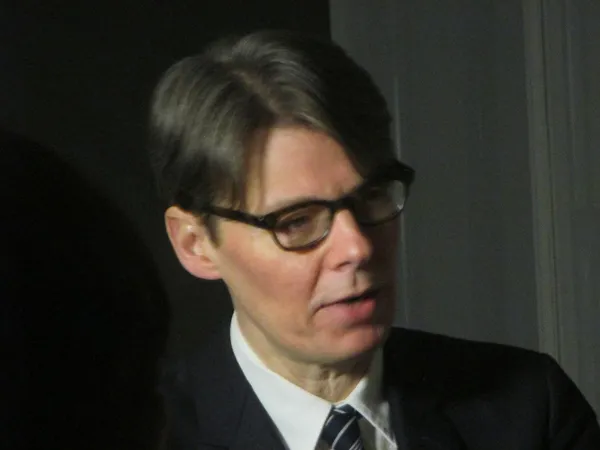 |
| Andrew Bolton: "Yves Saint Laurent is one of my favorite designers." Photo: Anne-Katrin Titze |
At The Metropolitan Museum of Art Costume Institute Manus X Machina: Fashion In An Age Of Technology Benefit Gala last night, Saoirse Ronan, Kate Hudson, Lupita Nyong'o, Nicole Kidman, Bradley Cooper, Emily Blunt, Olivia Wilde, Dakota Johnson, Claire Danes, Hugh Dancy, Sienna Miller, Uma Thurman, Rachel McAdams, Brie Larson, David O Russell, Zoe Saldana, Emma Stone, Freida Pinto, Jessica Chastain, Naomi Watts, Kate Bosworth, Emma Watson, Robert Pattinson, Katie Holmes, Jennifer Connelly, Chloë Sevigny, Kerry Washington, Elle Fanning, Dakota Fanning, Alicia Vikander, Michelle Williams, Sarah Jessica Parker, Madonna, Beyoncé, Lady Gaga, Kanye West and Diane von Furstenberg were among those in attendance.
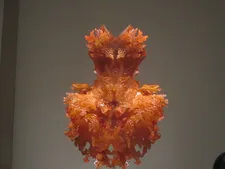 |
| Iris van Herpen 3-D-printed dress by Materialise Photo: Anne-Katrin Titze |
In 2015, The Met Costume Institute China: Through The Looking Glass exhibition, curated by Andrew Bolton, with clips edited by The Grandmaster director Wong Kar Wai, was a smash hit, magically merging film with fashion and the museum's collection. Andrew Rossi documented the creation in The First Monday In May, this year's Opening Night Gala selection of the Tribeca Film Festival.
As I walked the Manus X Machina: Fashion In An Age Of Technology exhibition at the press preview, my mind wandered from Robert Bresson and Jean Cocteau's film adaption of Denis Diderot's Les Dames Du Bois De Boulogne, with fabulous dresses by Madame Grès and Elsa Schiaparelli, to Jalil Lespert's bold and beautiful film Yves Saint Laurent. Matthew Barney's Cremaster and a David Cronenberg Naked Lunch Mugwump with some Dead Ringers "cutlery", used by the twins played by Jeremy Irons, were conjured up after coming upon an Iris van Herpen 3-D-printed dress by Materialise.
The show challenges our often deeply conditioned reaction to garments we perceive as machine or handmade. The craftsmanship and exquisite beauty of what is on display guides us into the past and the future. It makes sense that I feel protective of a Callot Soeurs dress and somehow convinced that the golden Prada lace can be armor for a long time to come.
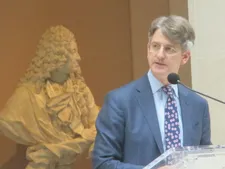 |
| Director of The Met, Thomas P Campbell, delivers opening remarks at the press preview. Photo: Anne-Katrin Titze |
At the upper Robert Lehman Gallery there is a statement by Miuccia Prada worth noting: "I use so many processes in my work - some that involve the hand and some that involve the machine. For me, mixing the hand and the machine gives the best results. I don’t think the hand and the machine have any use or value on their own. What matters is the form in relationship with the idea."
Denis Diderot and Jean le Rond d’Alembert’s Encyclopédie, Ou Dictionnaire Raisonné Des Sciences, Des Arts Et Des Métiers (1751–72) is on display as much more than a side attraction. This publication of the Enlightenment was in itself groundbreaking in recognising the skills and craft involved in dressmaking as an art. It thus perfectly functions as a structuring device for the exhibition. Embroidery, featherwork, and artificial flowers are shown on the upper floor of The Met's Robert Lehman Wing, while pleating, lacework, and leatherwork are explored below, together with detail-oriented sections on the workings of couture houses.
On the afternoon of the Costume Institute Benefit Gala with Idris Elba, Apple Chief Design Officer Jony Ive, Taylor Swift and Anna Wintour as Co-Chairs, and Nicolas Ghesquière, Karl Lagerfeld, and Miuccia Prada as Honorary Chairs, I spoke with Andrew Bolton, Curator in Charge of the Costume Institute, about his serenely informative and beautifully daring integration of the concrete and the sublime.
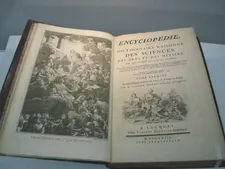 |
| Denis Diderot and Jean le Rond d’Alembert's Encyclopédie: "The first time that somebody had equated dressmaking as art." Photo: Anne-Katrin Titze |
Anne-Katrin Titze: It's such a fantastic idea to use Diderot's Encyclopédie as, I don't know, skeleton, of the exhibition. It is a bit like the use of Edward Said in China: Through The Looking Glass.
Andrew Bolton: Yes, very much. That's a good analogy. You know, it really was such a provocative, controversial publication in his day. But more than that, I think it was the fact that it really was the first time that somebody had equated dressmaking as art. He put it on the same level as the arts and sciences.
So it was nice to anchor the show in a sort of philosophical discourse that preceded the exhibition. What he outlined in the encyclopedia was hand - machine, so basically it was an earlier examination of a theme that we are looking at in the exhibition.
AKT: You mentioned [in the opening remarks] that the Mondrian dresses from the Yves Saint Laurent collection were the trigger for the exhibit. Is that the moment shown in Andrew Rossi's film? [InThe First Monday in May, we see Bolton examining and commenting on the Mondrian dresses in the YSL Fondation's Paris archives].
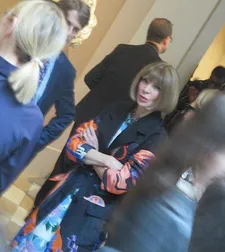 |
| Condé Nast Artistic Director and Vogue Editor-in-Chief Anna Wintour Photo: Anne-Katrin Titze |
AB: It is not, actually. We're lucky, we have one of our own. Yves Saint Laurent is one of my favourite designers. I think that people forget his innovations. He was so innovative and his innovations have become so accepted in fashion, that they are no longer radical. But in the day, it was radical. He really was a designer who sort of institutionalised prêt-à-porter through his Rive Gauche. So he is a pivotal figure in the history of fashion.
With the Mondrian dress, it really was surprising. Because even though I've always been aware that haute couture has machine elements I was surprised to the extent of the machine presence in the Mondrian dress. But it absolutely makes sense. To achieve those really strict lines of the Mondrian dress, you needed a machine to create that.
To me, it made me think, you know, if you're a good designer, it doesn't matter if it's machine or hand. It's about what will give the best result for your intentions. Saint Laurent did that. And I think Karl [Lagerfeld] does that. The good designers use techniques in a way that allows them to achieve their end result, their goal.
AKT: The feel of the exhibit has something of a church, also the music. You are playing with the title which is Manus X Machina but everybody thinks first, of course, of Deus ex machina.
AB: That's very much part of the idea.
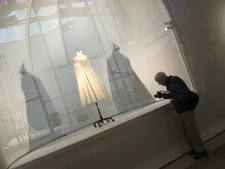 |
| New York Times photographer Bill Cunningham - L’Eléphant Blanc dress by Yves Saint Laurent for his debut collection for the House of Dior Photo: Anne-Katrin Titze |
AKT: So God is deconstructed in fashion?
AB: That's nice. That was very intentional, so it's nice that you picked that up. Yeah, it is a temple to beauty, a temple to the artistry of fashion and it's also a sanctuary, I think. And then the music, I think, is very transporting. I was very keen to sort of slow down visitors so that they could actually look at the work.
More than any show we've done before, it really is about process and technique - you have to read the labels to understand how that garment has been constructed. I want the show to finally put an end to is fashion as art debate. It is undeniable as an art form and I think we should start asking different questions than is fashion art?
AKT: Film has gone through this.
AB: Absolutely, photography.
AKT: There is nothing directly film-related here?
AB: In this one? No, there's videos. There's a few videos. Actually we have sort of projections and we have videos of some of the garments in the making.
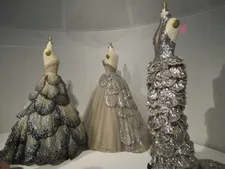 |
| Masters of embroidery - Christian Dior and Alexander McQueen Photo: Anne-Katrin Titze |
AKT: As Billy Wilder said, do one thing and then do the exact opposite.
AB: The opposite, exactly.
AKT: Is that what your motto is for the Costume Institute?
AB: Very much, yeah. Always!
The exhibition features more than 150 examples of haute couture and avant-garde ready-to-wear, dating from the early 20th century to the present.
The Manus X Machina: Fashion In An Age Of Technology exhibition presented by Apple with additional support from Condé Nast will be open to the public from May 5 through August 14, 2016.





















